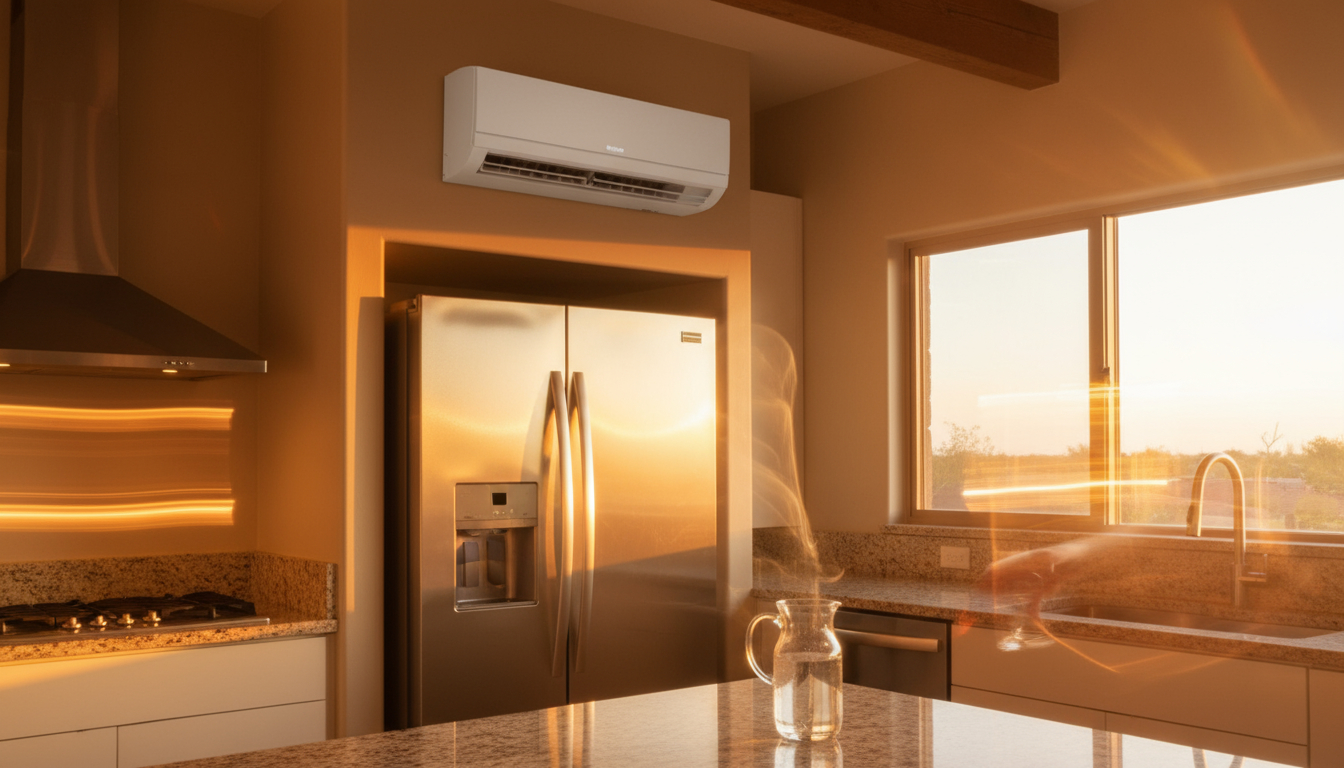

In the scorching Arizona sun, where summer temperatures routinely climb above 110°F, keeping your home cool and comfortable presents a real challenge. Traditional central air conditioning systems often struggle with uneven cooling, high energy bills, and outdated ductwork that leaks efficiency. Enter ductless mini-split systems—a modern HVAC solution gaining popularity in Arizona homes. These versatile units offer targeted cooling and heating without the need for extensive ducting, making them ideal for our desert climate.
If you’re a homeowner in Phoenix, Tucson, or anywhere in the Valley of the Sun, you might wonder: Are ductless mini-splits right for your space? This guide dives deep into the pros and cons of ductless mini-split systems for Arizona homes. We’ll explore how they work, their benefits for energy savings and comfort, potential drawbacks, and practical tips to solve common installation hurdles. By the end, you’ll have the knowledge to decide if this system fits your lifestyle, backed by insights from years of HVAC experience in the region.
What Are Ductless Mini-Split Systems?
Ductless mini-split systems, also known as ductless AC units or mini-split heat pumps, consist of an outdoor compressor connected to one or more indoor air-handling units via refrigerant lines. Unlike traditional HVAC systems that rely on ducts to distribute air throughout the house, mini-splits deliver conditioned air directly into specific rooms or zones.
Each indoor unit mounts on a wall or ceiling and operates independently, controlled by a remote or app. This zoned approach allows you to cool or heat only the rooms you use, which is particularly advantageous in Arizona’s variable indoor-outdoor temperature swings. For instance, during monsoon season, you can cool the bedroom at night while leaving the garage uncooled.

These systems use inverter technology to adjust compressor speed, ensuring efficient operation. In Arizona, where cooling demands peak from May to September, mini-splits shine by providing quick, precise temperature control. According to energy experts, they can achieve SEER ratings (Seasonal Energy Efficiency Ratio) up to 30, far surpassing many older central systems rated at 14 or less.
Pros of Ductless Mini-Split Systems for Arizona Homes
Arizona’s arid heat and dust make reliable, efficient cooling essential. Ductless mini-splits address these issues head-on, offering several advantages tailored to our local environment.
Energy Efficiency and Cost Savings
One of the biggest pros is their superior energy efficiency. In Arizona homes, where air conditioning runs nearly year-round, mini-splits can reduce energy bills by 20-30% compared to ducted systems. The absence of ducts eliminates energy loss—up to 30% of cooled air escapes through leaky ducts in traditional setups. For a typical 2,000-square-foot Phoenix home, this could translate to hundreds of dollars saved annually.
Zoned cooling further boosts savings. Why cool an empty office or guest room? Mini-splits let you target usage, solving the problem of overworking your AC during Arizona’s long, hot days. Plus, many models qualify for federal tax credits under the Inflation Reduction Act, potentially offsetting installation costs by up to $2,000.
Easy Installation and Flexibility
Retrofitting ductwork in older Arizona ranch-style homes or adobe structures is often impractical and expensive. Ductless systems bypass this entirely, requiring only a small hole in the wall for connections. Installation typically takes 1-2 days per unit, minimizing disruption—crucial if you’re dealing with summer heat without AC.
Their flexibility suits Arizona’s diverse home layouts, from sprawling single-story homes to multi-level condos in Scottsdale. You can add units as needed, starting with one for high-traffic areas like the living room. This modular design solves common problems like uneven cooling in homes with poor insulation, common in older Valley properties built before modern energy codes.
Improved Comfort and Air Quality
In dusty Arizona, where pollen and sand infiltrate homes, mini-splits enhance indoor air quality. Most units include multi-stage filtration, capturing particles that central systems might recirculate through ducts. This is a game-changer for allergy sufferers or those with respiratory issues exacerbated by monsoon humidity.
Comfort comes from precise temperature control. Mini-splits maintain steady temps without the hot/cold spots of ducted air. In Arizona’s extreme climate, where indoor humidity can spike during rare rains, dehumidification features keep spaces dry and comfortable, preventing mold growth—a frequent issue in poorly ventilated homes.
Quiet Operation and Aesthetic Appeal
No noisy blower fans or duct rattles here. Indoor units operate at whisper-quiet levels (as low as 19 decibels), ideal for Arizona bedrooms where sleep is precious amid 100°F+ days. Sleek, compact designs blend into walls, preserving the Southwest aesthetic without bulky vents.
Cons and Challenges of Ductless Mini-Split Systems in Arizona
While ductless mini-splits offer clear benefits, they’re not without drawbacks, especially in Arizona’s harsh conditions. Understanding these helps you weigh options and avoid pitfalls.
Higher Upfront Costs
The initial investment is a notable con. A single-zone system for a small Arizona room costs $2,000-$5,000 installed, while multi-zone setups for a whole home can exceed $10,000. This is steeper than repairing an existing central system, which might run $1,500-$4,000. For budget-conscious homeowners in Tucson or Mesa, this upfront hit solves short-term cash flow issues but delays ROI—typically 3-5 years through energy savings.
Arizona’s extreme heat also influences pricing; units rated for high ambient temperatures (up to 115°F) add to the cost but are necessary for reliable performance.
Maintenance and Durability Concerns
Dust and dry air in Arizona can clog filters faster, requiring monthly cleaning to maintain efficiency. Neglect this, and you’ll face reduced airflow, higher bills, and potential breakdowns. Outdoor units exposed to intense UV rays and blowing sand need protective covers and annual professional servicing, adding $150-$300 yearly.
In rare cases, refrigerant leaks occur if lines aren’t properly sealed against Arizona’s temperature fluctuations. While modern systems are durable, they’re not invincible—warranties often cover 10 years on compressors, but labor isn’t always included.
Aesthetic and Space Limitations
Wall-mounted indoor units, while slim, aren’t invisible. In open-concept Arizona homes, they might clash with decor, and ceiling cassettes take up valuable space in low-ceiling rooms. For larger homes (over 2,500 sq ft), multiple units could feel cluttered, complicating the zoned benefit.
Cooling capacity limits another challenge. Mini-splits excel in smaller zones but may underperform in vast, sun-baked great rooms without supplemental units, potentially leading to inconsistent comfort during peak heat waves.
Potential for Over-Reliance on Zoning
Zoning is a pro, but mismanagement can create temperature imbalances. Forgetting to adjust unused zones wastes energy, countering savings. In family homes, this requires discipline—solving it involves smart thermostats, but added tech means more points of failure in Arizona’s power-outage-prone monsoons.
Installation and Maintenance Tips for Arizona Homes
To maximize benefits and minimize cons, follow these problem-solving steps for ductless mini-split success in Arizona.
Choosing the Right System
Assess your home’s size, insulation, and sun exposure. For Arizona’s heat, select systems with high SEER2 ratings and hyper-heat capabilities for mild winters. Consult a local HVAC pro to calculate BTU needs—oversizing leads to short-cycling and inefficiency, while undersizing strains the unit.
Position outdoor units in shaded, debris-free spots to combat dust buildup. Indoor units work best high on walls, away from direct sunlight or heat sources like fireplaces.
Step-by-Step Installation Guide
- Site Evaluation: Hire a certified technician to check electrical capacity and refrigerant line routes. In Arizona, ensure compliance with local building codes for seismic and wind resistance.
- Professional Setup: Avoid DIY—improper installation voids warranties and risks leaks. Expect vacuuming lines to remove air and charging with eco-friendly R-410A refrigerant.
- Testing: Run the system for 24 hours post-install to verify even cooling. Adjust vanes for optimal airflow in dusty conditions.
Ongoing Maintenance Routine
Clean filters bi-weekly during peak season to prevent efficiency drops. Schedule annual tune-ups to inspect coils and drains, especially before summer. Use UV filters for Arizona’s allergens. Monitor via apps for early issue detection, like low refrigerant alerts.
These habits solve 80% of common problems, extending system life to 15-20 years.
Comparing Ductless Mini-Splits to Traditional HVAC in Arizona
| Feature | Ductless Mini-Splits | Traditional Central HVAC |
| Efficiency (SEER) | 20-30 (zoned, no duct loss) | 14-20 (duct losses reduce effective rating) |
| Installation Cost | $2,000-$15,000 (per home) | $5,000-$12,000 (ductwork extra) |
| Best For | Additions, retrofits, zoned control | New builds, uniform cooling needs |
| Arizona Suitability | Excellent for heat/dust; flexible | Good but prone to leaks in old homes |
| Maintenance | Easier, room-specific | Duct cleaning required annually |
| Energy Savings | 20-40% in variable-use homes | Baseline; higher in well-insulated |
In Arizona, mini-splits often outperform traditional systems for retrofits, but central HVAC suits new constructions with existing ducts.
Final Thoughts: Is a Ductless Mini-Split Right for Your Arizona Home?
Ductless mini-split systems offer a smart, efficient solution for Arizona’s demanding climate, balancing pros like energy savings and zoned comfort against cons such as upfront costs and maintenance needs. They solve key problems like uneven cooling and high bills, making them a worthwhile investment for many homeowners.
For expert installation and service tailored to Arizona conditions, contact Emergency Master Plumbing & Air at 623-584-4706. Our team specializes in ductless mini-splits, ensuring reliable performance that keeps your home cool year-round. Schedule a free consultation today to explore how we can upgrade your HVAC setup.
